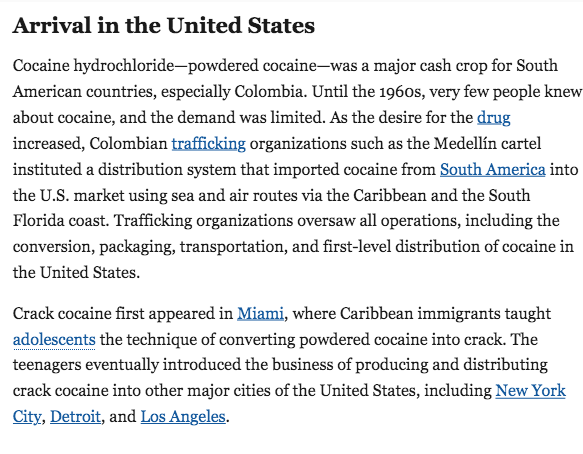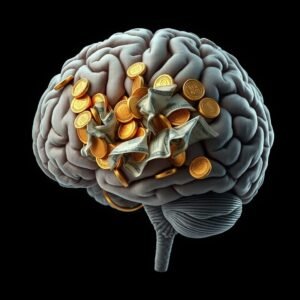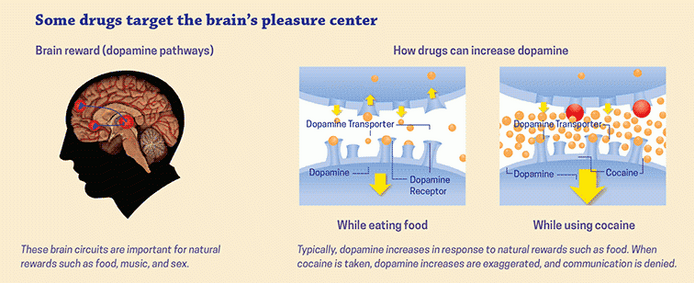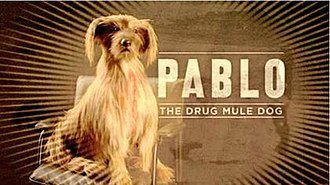
In this article, I explore how money is the most addictive legalized drug available for Canadian companies, and how it may be obtained through illegal practices. In this sense, it is comparable to a cocaine addiction. As such, an exploration of the current definition of White-Collar Crime is provided, along with some applicable Sociology theories and Psychology findings. As a result, this article seeks to explain the addictive nature of money with empirical research as supportive evidence on how addictions work within the biological construction of the brain and its use of dopamine.
This article also briefly explores some current policies and regulations in place regarding corruption related crimes. A list of research sources and their links, as discussed in this article, is provided at the end.
Aedipus International Associate Presss
with Guest Contributor, Sheila Wanite Bautz, English HBA & Sociology HBA 2025
Two Types of Criminals: White-Collar Criminals & Common Criminals
There are two types of criminals: The elite criminal at the top of the financial food chain, known as white-collar criminals, and common criminals, who are members of the public. Sometimes, common criminals hang out with wealthy people with a false sense that they too are elite, but that is another topic…

Kairos Anggadol (2020) published an article entitled “White-collar crime is a growing concern for Canadian companies” in the Canadian Lawyer magazine. In it, she stated that “A white-collar crime is a non-violent offence, whose core is fraud, malice, deceit, or concealment, and for the purpose of personal or corporate gain” (Anggadol 2020). The writer further went on to explain that the difference between the two types of criminals was their capacity for violence. She advocated that common criminals were violent and corporate criminals were not (Anggadol 2024). Blatantly FALSE. I make no apologies for disagreeing, flock that! Although I am sure she means well, sipping champagne, she obviously doesn’t have any real life experience, and that is why I Am… here to bust the myths.
Anggadol also attempted to claim that white-collar criminals are more intelligent and strategic, and stealthy… while implying that their “mental skills” are higher than the basic criminal (Anggadol 2024). This is also so FALSE, I should give an on-line course about this. First, let me tell you the truth about manipulative criminal minds, regardless of their income level.
The Unbiased Truth About Manipulative Criminal Minds: White-collar & common criminals are one in the same
The perceived “brilliance” of high-status criminals results due to their experience with manipulation tactics. Clinical studies prove that the less intelligent an individual is, the more apt they are to use manipulation as a tool to achieve their goals. This is due to the fact that they do not have the intelligence to function without manipulative tactics, much like an addict whose brain is damaged due to cocaine usage. (Hamzelou 2017).
READ THE ARTICLE: REAL-LIFE PSYCHOPATHS ACTUALLY HAVE BELOW-AVERAGE INTELLIGENCE
In addition, such people often show test results consistent with the diagnosis of a psychopath. (Hamzelou 2017). Not a spur of the moment “oh, my ex is a psychopath”, but a REAL psychopath, which your ex just might be. I don’t know, get them tested. Anyway – Psychopaths are also prone to drug and substance abuse, and money creates the same physical effect in the brain as an addictive substance. (Hamzelou 2017).
White-Collar Criminals: Bias for a high chance of receiving preferential treatment within the legal system

As a result, based on evidence, white-collar criminals have a high chance of receiving preferential treatment within the legal system. The average or common criminal does not. This is due often due to legal bias based on a willful blind eye to the evidence or selective ignorance, depending on who the criminal is. This includes media coverage of crimes, who is held accountable, what happens during the prosecution, and what the resulting penalties are, or lack there of, depending on which type of criminal the perpetrator is labelled as. (Anggadol 2024; Braithwaite 1989).
Corruption is like a brain corroded on cocaine
Corruption is like a brain corroded on cocaine. Morals depart. Compassion departs. The ability to utilize common sense departs. Corruption weaponizes the addiction for money in order to shield criminal activity and enforce a strategic goal of controlling legal outcomes to get away with the crime. For some, this produces an effect that is likened to getting high off a drug through getting away with the crime.
Through the manipulative and strategic financial misuse of financial funds, the intent is to create self-enrichment through a massive abuse of power, which is also addictive for many. In this way, and often times, the average Canadian citizen affected by the elite cultural circle generating millions of dollars do not have the same weaponry in financial tools to assist with empowering themselves in order to protect their own interests. Thus, the interests of the public’s equity in order to sustain a fair economic distribution amongst the general public is diminished. This also demonstrates a deficiency within the key areas of business and government meant to uphold the highest standards of integrity.
White-Collar Crime for the addictive high of money

According to other legal experts who published their findings in the Chambers Global Practice Guides (2020) entitled “White-Collar Crime: Definitive global law guides offering comparative analysis from top-ranked lawyers”, it is explained how white-collar crime for the love of money works. White-collar crime, as it applies and pertains to financial gains for elite criminal minds, includes a variety of money focused financial enrichment schemes. These manipulative schemes include, but are not limited to, various forms of theft such as extortion, bribery, love frauds, influence peddling (such as supply-side corruption), embezzlement, investment frauds, and tax evasion. (Anggadol 2024; Baker McKenzie LLP et al 2020).
Bias: Between white-collar criminals and common criminals
The imbalance of legal penalties, otherwise known as bias, between white-collar criminals and common citizens who commit the same crime creates a label for the offender who is penalized. Deviance, which is when someone defies social norms and becomes deviant, is defined differently for the common citizen as opposed to the elite. With ordinary citizens, the deviance is a negative label while for the elite, it is celebrated as being in the top 10 percentile for success.
Deviance: A goal for profits above people

Although deviance exists in both sub-cultures, morphing into accepted norms within them, both have a social hierarchy of power that dictates the main goal: profits above people. The Subcultural Theory applies to this aspect of criminal behaviour where the rules are defined by each group or sub-culture. For the elite with major high-profile connections to social capital, they conduct themselves with a collective agreement on what is normalized for the millionaires club while conducting business. (Braithwaite 1989; Friedrichs 2009; Lumen Learning nd).
This is no different than an organized street gang who’s leader ensures a human network is in place with similar human currency and clout to allow them control and immunity from punishment. This assists both groups and their people in positions of power with a perceived sense of evasion from mainstream society’s established rules through their deviance. Basically, they start to believe the same rules and laws that are created for a functional society do not apply to them. They feel they are above the law of the common people, whether they are a common criminal or a white-collar criminal. Two in the same. (Braithwaite 1989; Friedrichs 2009; Lumen Learning nd).
Colombia Started It: A powerful 1980’s legal example of Colombia trafficking Cocaine into the USA for elites & Crack for common citizens (VIDEO in section)
Americans and Canadians did not have access to the highly addictive drug known as cocaine until the rampant greed of Colombians charted out on the new territories to contaminate North America with it. Cocaine has been a normalized way of life for Colombia for thousands of years, bringing many other serious crimes against humanity with it, which is perceived as “normal”. This includes prostitution, theft, abhorrently dishonest practices, crimes against children who are born to addicted mothers, farms specializing in the growth, and promoting a toxic society that comes with addictive substances.
In the video below, Colombia cocaine farmers state that they do not want to be stigmatized as a criminal, even though they are selling cocaine to cartels who are violent and murderous. Cocaine growth and usage is normalized in Colombia, and has been so for thousands of years.
As such, a powerful example is shown in the case of the 1980’s drug epidemic that occurred in the United States of America (USA), which also impacted Canada as well. (Lumen Learning nd). The drug epidemic crossed class stratifications and affected the elite community and the low socioeconomic communities without prejudice. Both had an addiction to a different form of one highly addictive drug: crack and cocaine is one in the same. (Lumen Learning nd).

Cocaine was used by elites in powerful positions while crack was the “poor man’s” choice. (Lumen Learning nd). In 1986, USA federal laws mandated that “being caught in possession of 50 grams of crack was punishable by a ten-year prison sentence”, but that elite cocaine addicts were criminalized if they had 5,000 grams of white powder in their possession” (Lumen Learning nd). Punishment in comparison was grossly skewed with 1 to 100 ratio for elite users of the same drug in a different form. (Lumen Learning nd).
This in turn is seen as creating an “inequality in the severity of punishment for crack versus cocaine” which is “paralleled [with] the class and race of the respective users” (Lumen Learning nd). It is important to note that those in power positions with a wealth of financial enrichment also have a powerful network with social capital whose members create the laws, and who often determine who is granted leniency from criminal charges and who is ultimately administered punishments. (Lumen Learning nd). By 2010, “President Obama signed the Fair Sentencing Act, which decreased the disparity to 1 to 18 (The Sentencing Project 2010)” (Lumen Learning nd).
This drug example is comparable to why white-collar criminals are significantly less likely to be disciplined for their corruption when it comes to their addiction to money, which has a similar high effect as a drug. It also demonstrates how government can create policies to lessen the gap between social groups in the pursuit of justice.
Blame The Dopamine: How money addiction functions like cocaine addiction due to the physiological chemistry in the brain
Regardless of the substance or developed habit, addictions function in the same way due to the physiological chemistry in the brain. This is based on a type of reward system associated with conditioning the mind to seek a high. The empirical article “The neurology of addiction” explains how neurobiological changes occur in the brain as they pertain to addictions. Money included.

It is important to note at this point that genetics also play a factor in addiction and moral integrity. Major addictions and social norms to consume substances like cocaine and alcohol, especially when consumed pregnant, alter or solidify genetics. The brain development of a child in utero is also seriously impacted. As such, children are born with damage to their frontal lobes, for instance, which makes them incapable of comprehending what is morally right, or to have empathy for two examples. Their brains can be comparable to a psychopath as a result.
In the neurobiology of addiction, there is “a heuristic three‐stage addiction cycle framework: binge/intoxication, withdrawal/negative affect, and preoccupation/anticipation” (Uhl et al 2019). The study also describes how addictions are “established by rewarding processes, can be maintained by altering motivation, including… establishing compulsive‐like habits… and facilitating impulsivity” (Uhl et al 2019). The addictive nature of a drug is the substance’s ability to manipulate and take over the dopamine system in a brain by increasing its levels. (Uhl et al 2019).

As dopamine plays a crucial role in addiction, there are two receptors involved known as dopamine D1 and D2, located in the prefrontal cortex. (Uhl et al 2019). This is the same region where moral reasoning occurs. Normally, brains receive a consistent and moderate flow of dopamine. (Uhl et al 2019). When unexpected events in life are experienced suddenly, stimulating a person, a “phasic firing” occurs that excites and elevates the D1 dopamine receptors and creates a rush or a high for the person experiencing the event. (Uhl et al 2019). Thus, over stimulation occurs.
Sudden Elevations in High Dopamine: Concentrations from life events — physical drug not required for the same high results
A drug is not required, as the same high results due to literal life events and experiences when there is a sudden elevation in high dopamine concentrations that are “produced by phasic firing and thus activate both D1 and D2 receptors” (Uhl et al 2019). Thus, without a substance in the body, but through an experience, there is the reward of the feeling of being on top of the world. The researchers found that this in turn begins to condition a person with the memory of the feeling of elation to associate life events they want to relive, much the same way substance abuse provides a reward. (Uhl et al 2019). Blame it on the dopamine… maybe.
Like Pablo’s Dogs: Conditioned to seek a high reward
Like Pablo’s dogs, a conditioned response and a seek for the reward obedience takes effect. However, in some cases, the rush of a life event is associated with a punishment. (Uhl et al 2019). This is definitely applicable to the rush or reward of money, and the means used to attain it. When the con is successful at attaining a “high” through cruel, or illegal, criminal activity, and gets away with it, they want to experience it again. It becomes an addiction that has physiological effects and rewards on multiple levels, which is similar to using an illegal drug.

Further findings in the empirical published article, “The neurology of addiction”, included the powerful effect that a simple visual stimulant will trigger in memory form. The memory will invoke the elated feeling, which is a motivation for the person to repeat the use of either a drug or an action that produced the elated high feeling. (Uhl et al 2019). Often times, bonafide psychopath tendencies are obvious and evident in such people, as they are void of any real emotion or empathy for others.
The same memory response was also tested on gambling addicts using a “functional magnetic resonance imaging (fMRI) to monitor the effects of reward prediction error on both brain activity and future behavior in subjects participating in a betting task in a fictitious market” (Uhl et al 2019). The study revealed that “how much a person gains versus how much they could have gained if they had bet more” was associated with “behavioral changes” (Uhl et al 2019). Developing habits over time due to conditioned behavioural response correlates with the rush of power experienced in power dynamics for the perceived elite classes in a society or social group.
Power does not equate, or correlate, to evil intentions: Power can also heighten positive motivation

It is extremely important to also note that power does not equate, or correlate, to evil intentions, as power can create a heightened motivation to empower others. In other studies, it was shown that high power in powerful positions also leads to wonderful attributes and contributions to society. This includes, but is not limited to, an improvement in empathy with people’s actions and emotional states of being. (Hogeveen 2014). The term coined is “prosocial orientation”, which leads to “improved empathetic abilities” in powerful people (Hogeveen 2014).
The difference perhaps is in the culture the individual achieving higher status is raised in while they are increasing their power. In addition, genetics, spirituality, education, social influences, and social arenas denote a certain accepted behaviour within an individual’s culture.
Dimensions of the Culture: A strong influence of what is acceptable in white-collar & common crime
The dimensions of the culture that a person belongs to can strongly influence what is considered acceptable behaviour, including in the context of white-collar crime and common crime when it comes to money. This is true for all social groups, stratifications, demographics and countries with sub-cultures. For instance, there is the dominant main stream culture of Canadian society. Within our country, there are sub-cultures, such as the French communities, or the Asian communities. Within those communities, there is also a family culture, yet at work, there is the work culture. You can see where I am going with this.


Various aspects of a main cultural identity and the collective group’s, and sub-group’s, accepted im/moral compass determines the type of behaviour that will be normalized within that group or culture. In addition, each person’s inherited genetic dynamics combine to contribute to determining the resulting character in the developing the person. (Hogeveen 2014). This includes how their brains are affected through experiences that release an increase of dopamine. (Hogeveen 2014). Thus, money can also be a powerful instrument of generosity, humanity, and good works regardless of their income level and personal achievements, as an array of influences combine within a person. This is also true in the case of culture clashes.
As a team member, it’s important for you to understand the unique challenges that cultural differences bring to team life—both your own culture, and the cultures of other team members. In his research on comparative cultures, Dr. Geert Hofstede showed that there are some characteristics of culture that can drive a person’s behaviour. As culture helps determine our internal values and attitudes, it can play an important role when it comes to teamwork. Hofstede identified five cultural dimensions… READ MORE HERE
However, when money becomes a key focus and goal, an addiction, is done so within a particular culture, finances are also weaponized. The additional power is basically the infused weaponry of finances, which can lead to either collective stupidity and cruelty or collective positive progress and humanitarian work for instance. Weaponized money enters with a goal to protect the addiction to money to cause destruction through the addiction response. It can, however, also assist with elevating humanity to provide relief from suffering within the populations. (Hogeveen 2014). Addictive personalities are more prone to administer cruel and unusual punishments, and weaponize money to protect their money addiction.
The Government of Canada: Government Policies and the Criminal Code
According to the Government of Canada, government policies, “which may serve to assist policy development regarding corruption and corruption-related crime” are continually being developed (Government of Canada 2022). White-Collar crimes are applicable to “federal criminal and administrative laws, such as: Criminal Code, the Conflict of Interest Act, The Lobbying Act and others” (Baker McKenzie LLP 2020). However, since provincial and territorial laws and regulations across Canada are not governed by the federal laws, there is the possibility of a low chance for many white-collar crimes to avoid being penalized. (Baker McKenzie LLP 2020).
This in turn creates a high recidivism rate in corporations who are not formally charged and punished. (Anggadol 2024). Quebec is the exception to this issue as they have a provincial Anti-Corruption Act establishing a low tolerance for white-collar crime in order to protect the public, including with the misuse of public funds. (Baker McKenzie LLP 2020). As it pertains to all white-collar criminals, when penalties are administered, they include imprisonment. (Anggadol 2024).
White-collar case concluded: Money is the most addictive legalized drug for Canadian companies
Money can literally affect the brain’s chemistry and alter it precisely the way a drug will, if not kept in check. Money is comparable to a legalized tool meant to protect the addictive substance. Protect money with money in the cycle of the financial addiction. Through research, money is considered an equivalent to the most addictive drug, particularly for an addictive personality. An overdose of it and its false sense of security, which it creates through its ability to enhance the feeling of being powerful, can ultimately result in either criminal charges, or deaths in the extreme cases. Money is like a drug to those who misuse and abuse it, much like an addiction to cocaine, and it provides the same physiological consequences as any addiction.
The laws continue to amend to crack down on white-collar crime…
About International Authoress Sheila Wanite Bautz

Sheila Wanite Bautz is an International Authoress with expertise in 19th Century English Literature (HBA) and in Sociology (HBA 2025) with special areas of focus in criminology and law. Sheila has advocated on various government levels: including through the legal system to the Supreme Court of Canada with regard to the serious issues in the Saskatchewan court system with domestic violence, the best interests of the children and human rights violations. She is preparing to write another investigative true crime book on corrupt family court custody issues. Sheila Wanite is also the International Authoress of the acclaimed The Code Of The Bestia epic fantasy book series. A diverse writer with a robust published portfolio, Sheila’s interest and expertise are vast. Peruse her on-line resume and complete portfolio by CLICKING HERE.
Additional Article References:
Anggadol, Kairos. (2020). Updated 23 May 2024. White-collar crime is a growing concern for Canadian companies. Canadian Lawyer magazine.
Baker McKenzie LLP, Pirie, John, Latella, Matt, Gates, Arlan, and Sakamoto, Ben. (2020).
White-Collar Crime: Definitive global law guides offering comparative analysis from top-ranked lawyers. Chambers Global Practice Guides.
Bautz, Sheila. (2024). Walking The Cutline: When Companies Kill (2nd Edition). Aedipus Ink Empire Publishing; Aedipus Ink Evidentiary Series.
Braithwaite, J. (1989). Criminological Theory and Organizational Crime. Justice Quarterly, 6(3), 333-358.
Friedrichs, David O. (2009). Trusted Criminals: White Collar Crime in Contemporary Society, 4 th ed. Belmont, CA: Wadsworth, Cengage Learning.
Hamzelou, J. (2017). Real-life actually have below-average intelligence. New Scientist.
Hogeveen, J., Inzlicht, M., & Obhi, S. S. (2014). Power changes how the brain responds to others. Journal of Experimental Psychology: General, 143(2), 755–762.
Lumen Learning. (nd). Introduction to Sociology: Conflict Theory and Deviance. Module 6: Deviance, Crime, and Social Control. Lumen Learning.
Public Safety Canada, Government of Canada. (2022). Definitions of Corruption – Research Brief no. 48.
Uhl, G. R., Koob, G. F., & Cable, J. (2019). The neurobiology of addiction. Annals of the New York Academy of Sciences, 1451(1), 5–28.
